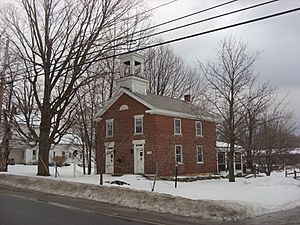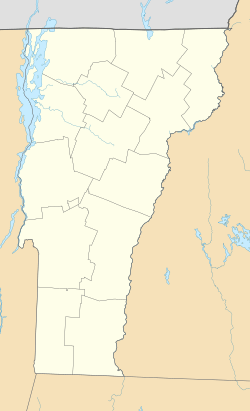Shaftsbury Center, Vermont facts for kids
Quick facts for kids
Shaftsbury Center, Vermont
|
|
|---|---|
 |
|
| Country | United States |
| State | Vermont |
| County | Bennington |
| Town | Shaftsbury |
| Area | |
| • Total | 2.2 sq mi (5.8 km2) |
| • Land | 2.2 sq mi (5.8 km2) |
| • Water | 0 sq mi (0.0 km2) |
| Time zone | UTC-5 (Eastern (EST)) |
| • Summer (DST) | UTC-4 (EDT) |
| ZIP code |
05262
|
| Area code(s) | 802 |
|
Center Shaftsbury Historic District
|
|
| Lua error in Module:Location_map at line 420: attempt to index field 'wikibase' (a nil value). | |
| Location | VT 7A, Shaftsbury, Vermont |
| Area | 260 acres (110 ha) |
| Architect | Huntington, Harlow |
| Architectural style | Greek Revival, Federal, Cape Cod |
| NRHP reference No. | 88002052 |
| Added to NRHP | November 9, 1988 |
Shaftsbury Center is a small community in the town of Shaftsbury, located in Bennington County, Vermont, United States. It's known as an unincorporated village, which means it's a recognized community without its own separate local government.
This village is found along Vermont Route 7A, where West Mountain and Tunic Roads meet. For a long time, up until the mid-1800s, Shaftsbury Center was the main hub for the town. Today, it's a quiet village with farms and businesses that welcome tourists. Most of the village is so special that it's listed on the National Register of Historic Places as the Center Shaftsbury Historic District. This means its old buildings and area are protected because of their historical importance.
Contents
Exploring Shaftsbury Center's Location
Shaftsbury Center is located right in the middle of the larger town of Shaftsbury. It stretches for about 1.6 kilometers (1 mile) along Vermont Route 7A. This road runs along the eastern side of the Taconic Range mountains.
From Shaftsbury Center, you can enjoy amazing views across the valley. You can see the Green Mountains even further to the east. It's a beautiful spot with lots of natural scenery.
A Look Back: Shaftsbury Center's History
The town of Shaftsbury was officially created in 1761. This happened when Benning Wentworth, who was the colonial governor of New Hampshire, claimed the land that is now Vermont. At that time, both New Hampshire and New York claimed this area.
Vermont's Path to Independence
The argument over who owned Vermont, then called the New Hampshire Grants, led to big changes. In 1777, Vermont declared itself an independent area, known as the Vermont Republic. It later became the 14th state in the United States.
Shaftsbury Center played a part in these important events. The inn owned by Jonas Galusha was a key meeting place. Jonas Galusha later became a governor of Vermont. People met there to discuss Vermont's independence and how Vermont men would help in the American Revolutionary War. Shaftsbury also offered safety to people involved in Shays' Rebellion (1786–87) in Massachusetts.
Growth and Change in the Village
As the main center of the town, Shaftsbury Center was home to the first church and the town's meeting hall. It grew as a farming community during the 1800s. However, things changed when the railroad was built through the town in 1850. The railroad didn't go through Shaftsbury Center.
This caused economic and town activities to move to South Shaftsbury. A new town hall was built there in 1880. Shaftsbury Center's economy slowed down until the early 1900s. That's when cars became popular, and tourism brought new life and money to the village.
Most of the buildings you see in Shaftsbury Center today were built before 1880. The oldest house, the Abiathar Waldo House, was built in 1764-1765. It was built by one of the first people to settle in the area. In 1988, most of the village was recognized as a historic district and added to the National Register of Historic Places.


